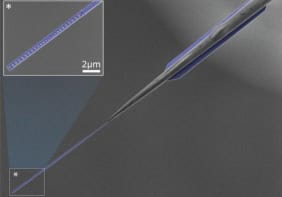By Matin Durrani
This is my second full day at the 25th International Conference on Low-Temperature Physics in Amsterdam — LT25 in the jargon — and it’s been a busy morning, despite last night’s marathon conference dinner at the five-star Hotel Krasnapolsky that lasted until gone 11 p.m.
Almost 600 delegates, myself included, were treated to a fairly decent three-course dinner that culminated in what was billed as a “grand dessert buffet”, which seemed to take forever to set up. Thankfully the wait for the profiteroles, fruit slices and cheesecake was ameliorated by a performance by a Dutch philosophy-graduate-turned-magician, whose name escapes me but who did some clever things with various delegates’ wedding rings.
We were also serenaded by a roving accordion player and guitarist who went from table to table and who claimed they could sing songs in 24 different languages. Which was great, I suppose, as long as you didn’t mind the fact they were all sung with a painfully thick Dutch accent. A Malaysian guy on my table, for example, seemed pretty unconvinced by the pair’s children’s song about a parrot.
But back to the physics. This morning I sat in on a session on “supersolids” — a strange new form of matter that some physicists think exists when helium-4 is cooled down to sufficiently low temperatures and subject to high enough pressure. The jury is still out on whether this form of matter exists, although the consensus, as far as I could tell from today, would be that it does.
The first really strong evidence for supersolids came in 2004 when a team led by Moses Chan from Penn State University in the US reported a series of experiments on a canister of solid helium-4, suspended by a thin torsion wire and made to oscillate at frequencies of about 1000 Hz by means of a motor.
Chen, who gave an update this morning of his latest data, had noticed that the oscillation period fell suddenly below a certain temperature. What causes this effect, dubbed “non-classical rotational inertia”, is the question. (Physics World ran a great feature on the subject last year for those who want to know more.)
If it is supersolidity, then what might be happening is that a certain fraction of the helium atoms — anything between 2% and 20% — form a Bose–Einstein condensate that can flow freely in and out of the rest of the “normal” solid helium, thereby changing the oscillation rate.
But there are other possible explanations, as theorist Matthias Graf of the Los Alamos National Laboratory discussed later on in the session. Graf told delegates it might be something to do with the material becoming glassy, while there also all sorts of issues to do with the solid’s grain boundaries. Certainly impurities in the helium-4, usually in the form of rogue helium-3 atoms, seem to play some sort of role.
However, after the session I quizzed John Reppy from Cornell University, who did some of the pioneering work on supersolids back in the 1970s. He seemed pretty convinced that supersolidity is real. Indeed, it was Reppy’s eloquent graduate student Sophie Rittner who had showed earlier in the morning that up to a fifth of the helium atoms could be in the superfluid phase.
So what’s the bottom line on supersolids? It looks like a case of: watch this space. Mind you, that hasn’t stopped the Korean Advanced Institute of Science and Technology (KAIST), at which Chen’s former grad student Eun-Seong Kim is based, from setting up a Center for Supersolid and Quantum Matter Research. That’s conviction for you.



